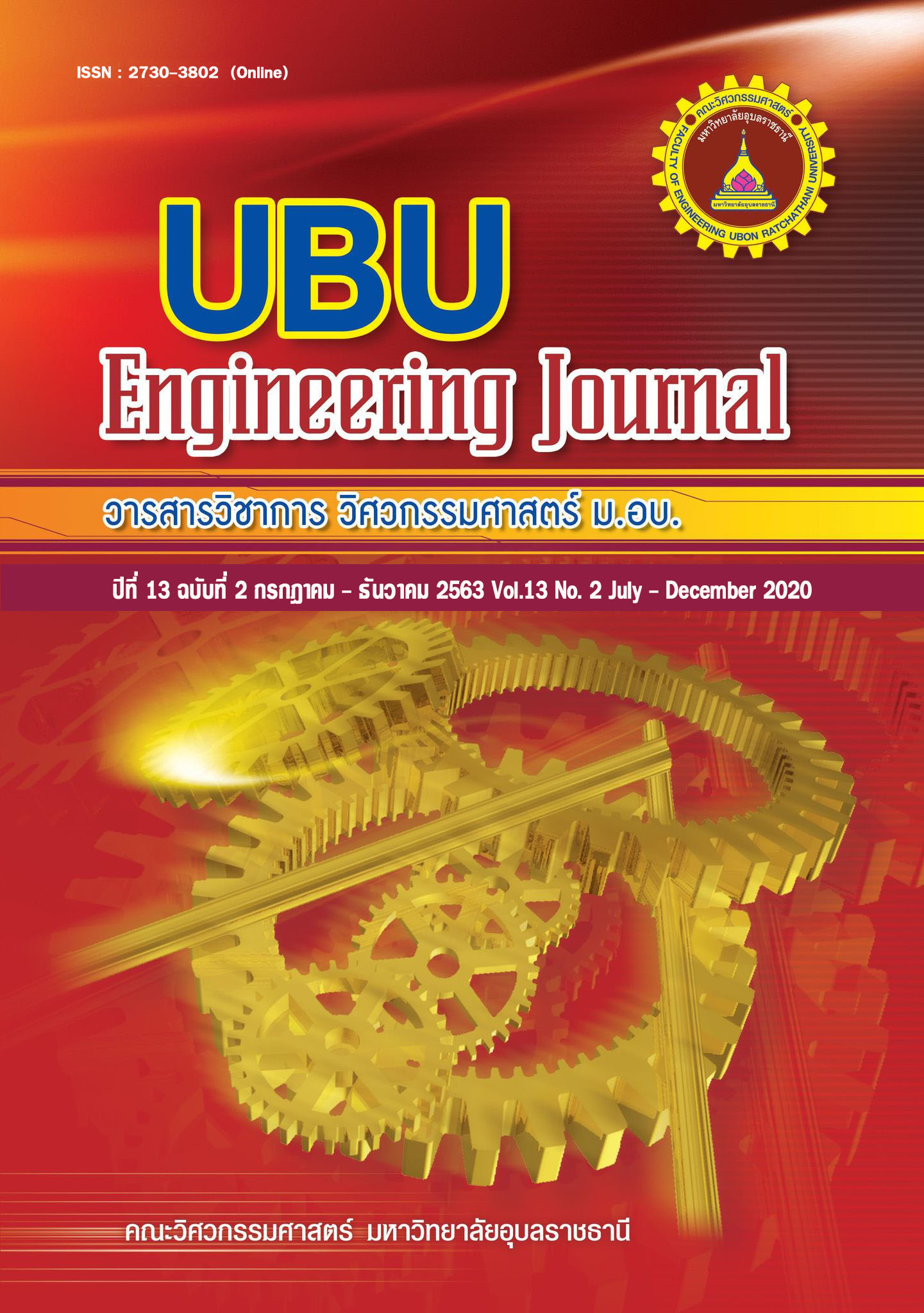Effects of coupling agent on mechanical and physical properties of spent coffee ground filled with polylactic acid composites
Main Article Content
Abstract
This study investigates the feasibility of using polylactic acid and coffee grounds to create environmentally friendly composites. The study applied the design of a statistical experiment to study two factors, namely coffee grounds mixing volume (10, 20 and 30% by weight) and the amount of the reaction substance (0, 1, 3 and 5 parts per hundred). The compositions were mixed by twin screw extruder and formed into specimen for testing the properties by the hot-pressing process. The results of the property testing and statistical analysis show that increasing coffee grounds increased the melting index, hardness, modulus of elasticity, and the percent elongation of the composite. The addition of a coupling agent led to an increase in tensile strength and modulus of elasticity. However, the regression analysis showed that the influence of both factors affected the properties, in which the relationship of factors can be modeled using quadratic polynomial model rather than simple linear model. Morphological analysis shows that coffee grounds should not be mixed more than 20% because it affects the stability and homogeneity of the composite. The results of the research show that 10% coffee grounds should be mixed with 5 parts per hundred, resulting in the properties of composites that are suitable for creating a product with unique color and aroma of coffee grounds.
Article Details
References
[2] นภัส ปัทมสัตยาสนธิ กัลทิมา เชาว์ชาญชัยกุล และณรงค์ฤทธิ์ สมบัติภพ. ผลของการบ่มเร่งสภาวะด้วยแสงยูวีและสารเคลือบผิวชนิดซีเรียมออกไซด์ที่มีผลต่อสมบัติเชิงกลและการเปลี่ยนแปลงโครงสร้างทางเคมีในคอมโพสิตระหว่างพีวีซีและผงขี้เลื่อยไม้. วารสารวิจัย มข (บศ), 2010; 10(2) : 1-9.
[3] ศุภศิษย์ ศรีอักขรินทร์ สันติ สุขสอาด วุฒิพล หัวเมืองแก้ว และทรงกลด จารุสมบัติ.การตลาดของผลิตภัณฑ์ไม้ประกอบพลาสติกในประเทศไทย. วารสารวนศาสตร์, 2555; 31(1) : 46-54.
[4] Andreas K. Wood Polymer Composites and their contribution to cascading utilization. Journal of Cleaner Production, 2016;110: 9-15.
[5] Yanjun X, Callum ASH, Zefang X, Holger M, Carsten M. Silane coupling agents used for natural fiber/polymer composites: A review. Composites: Part A, 2010;41 : 806–819.
[6] Yang S, Hyun JK, Hee JP, Bum LJ, Taek SH. Effect of compatibilizing agents on rice-husk flour reinforced polypropylene composites. Composite Structures. 2007;77: 45–55.
[7] Anuchit K., Utai M. Design of Experiment: Wood Composite Based on Crosslinked Polypropylene, The 18th International Conference on Composite Materials. 21-26 August 2011. Jeju island, Korea.
[8] Meekum U, Khongrit A. Toughening Of Wood Plastic Composite Based On X-PP, Proceeding of PPS-31:The 31st International Conference of the Polymer Processing Society, 7–11 June 2015, Jeju Island, Korea, doi: 10.1063/1.4942319.
[9] อนุชิต คงฤทธิ์, จิตติวัฒน์ นิธิกาญจนธาร. ผลกระทบของสารช่วยผสานที่มีต่อสมบัติทางกลและสมบัติทางกายภาพของคอมโพสิตพอลิโพรพิลีนผสมกากกาแฟ. วารสารวิชาการ วิศวกรรมศาสตร์ ม.อบ. 2018; 11(1): 18-28.
[10] Sarawut R, Watanachai S, Sarot J, Sunan T. Highly Filled Polypropylene Rubber Wood Flour Composites. Engineering Journal, 2011;15(2): 17-30.
[11] Mehdi T. Ghanbar E. Water Uptake and Mechanical Characteristics of Natural Filler-Polypropylene Composites, Journal of Applied Polymer Science, 2003;88 : 941-946.
[12] Sombatsompop N. and Chaochanchaikul K. 2004. Effect of Moisture Content on Mechanical Properties, Thermal and Structural Stability and Extrudate Texture of Poly(vinyl Chloride)/Wood Sawdust Composites. Polymer International, 53(9) : 1210-1218.
[13] Moe MT, Kin L. Effect of Environmental Aging on the Mechanical Properties of Bamboo-Glass Fiber Reinforced Polymer Matrix Hybrid Composites. 2002
[14] Chin-San W. Renewable Resource-Based Green Composites of Surface-Treated Spent Coffee Grounds and Polylactide: Characterisation and Biodegradability. Polymer Degradation and Stability, 2015; 121:51-59.
[15] García-García D, Carbonell A, Samper MD, García-Sanoguera D, Balart R. Green Composites Based on Polypropylene Matrix and Hydrophobized Spent Coffee Ground (SCG) Powder, Composites Part B. 2015; 78: 256-265.

